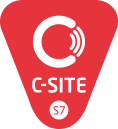This website uses cookies so that we can provide you with the best user experience possible. Cookie information is stored in your browser and performs functions such as recognising you when you return to our website and helping us to understand which sections of the website you find most interesting and useful.
Well Integrity Management Using Wireless IIoT Devices
Introduction
Well integrity is about containing and securing liquids and gasses in the well throughout the well life cycle. Advancements in wireless IIoT technology are transforming well integrity management in the oil and gas industry.
The C-site system enables effective well integrity management by leveraging real-time monitoring, predictive analytics, and mobile accessibility so that operators can enhance safety, minimize downtime & cost, increase production, and optimize maintenance activities.
This document outlines the key components, operational workflow, and benefits of a C-site wireless IIoT-based well integrity management system. The C-site system includes ATEX/IECEx certified field devices which collect data from assets and transfer the information wirelessly on to C-site M7 software.
Example Use Case: Leak Detection

A well’s pressure sensor detects unusual pressure buildup in annulus A. The AI-powered M7 platform correlates this data with historical patterns, identifying a potential tubing leak with the S7 measurement units. An alert is transferred wirelessly from the S7 unit to the R7 gateway and on to the cloud-based server and M7 software app.
The data is encrypted from the S7 unit all the way to the M7 software for further inspection and processing. The M7 software will show data from the annulus and the issue can be promptly addressed, preventing costly production downtime and avoiding environmental hazards.
How It Works
The C-site system consists of the S7 sensor unit, the R7 gateway and M7 software.

Battery operated, self organising sensor unit

Intelligent access point for wireless sensor units

Complete management software
With well integrity management, the wireless IIoT S7 sensor units continuously collect critical data on parameters such as:
- Flowline Pressure & Temperature: Track thermal gradients to detect abnormalities such as casing failures or fluid migrations.
- Wellhead Pressure: Pressure transducers are installed at the wellhead and casing to monitor pressure fluctuations that may signal integrity issues.
- Annulus Pressure: Annulus pressure is critical to ensure the integrity of the well. Pressure transducers allow operators to monitor annulus pressure and detect any possible issues with the tubing, casing or downhole equipment failure.
This data is transmitted wirelessly in real time to a R7 gateway unit which then delivers the data to the cloud-based C-site M7 software for further processing and analysis. Data delivered between the C-site system is encrypted and safe.

Data Analysis & Alerts on the M7 Software
The C-site system M7 software analyses incoming data to detect abnormal patterns using predictive analytics. The system displays well parameters, allowing operators to monitor conditions effectively. Abnormalities that can be measured, for example, are sudden pressure spikes that indicate risks such as blowouts or gradual temperature changes that can suggest potential casing or tubing failures. Alerts are sent to operators through email, SMS, or app notifications, ensuring rapid response to potential threats.
Proactive Maintenance
Predictive algorithms identify potential integrity issues before they escalate. The AI/ML algorithms enable data analysis to predict any possible failures before they occur. Maintenance teams can be dispatched based on real time data insights, reducing unnecessary site visits and enhancing operational efficiency which leads to an increase in production and sales.
For critical alarms, such as high casing pressure, the system triggers automated safety protocols such as emergency response teams are notified with precise GPS coordinates and operators receive actionable guidance through the mobile app.
Regulatory Reporting
Historical data is stored securely for audits and regulatory compliance, ensuring adherence to industry standards.
Key Benefits of The C-site System
Increased Production
By predicting maintenance needs and preventing equipment failures, C-site solution reduces unplanned shutdowns which in turn increases production time and profitability. Enhanced well & reservoir management could yield $3 savings in per barrel of oil equivalent, increasing sales.
Reduced Costs
Wireless C-site technology eliminates the need for extensive cabling, lowering installation costs and complexity. The M7 software insights improve decision-making and optimize maintenance scheduling. Predictive maintenance can reduce unplanned downtime by 20%-30%.
Enhanced Safety
Sensors enable early detection of issues (e.g. well leakage) & predictive analytics minimizes risks to personnel and environment. With less site visits safety & efficiency is increased.
Increased Efficiency
The M7 software’s AI and machine learning capabilities provide operators with actionable insights, enabling data-driven decision-making that increases efficiency. The system continually learns and improves, ensuring accurate and timely detection of issues which improves operations, e.g. minimizes engineering and field work.
Regulatory Compliance
Automated reporting simplifies adherence to industry standards and regulatory requirements. This reduces the administrative burden.
Conclusion
This wireless IIoT-based well integrity management solution exemplifies how modern technology can revolutionize traditional oil and gas operations.
By enabling real-time monitoring, predictive maintenance, and streamlined emergency responses, the system ensures enhanced safety, operational efficiency, and sustainability in the industry.